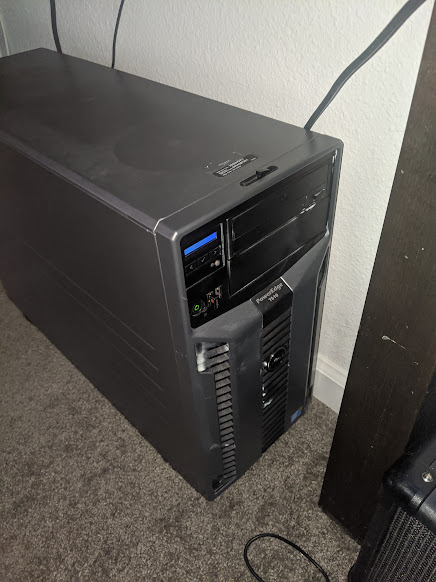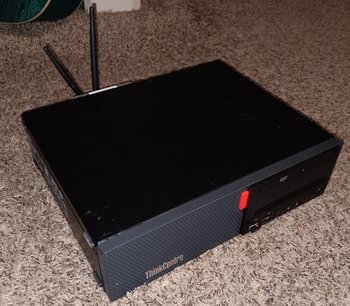 So it was the summer of 2020, COVID-19 was in full swing, and I was expressing interest in climbing the ladder so-to-speak in I.T., and one of the ways I wanted to, was to get into the interesting and wacky world of enterprise-class server hardware. So it was the summer of 2020, COVID-19 was in full swing, and I was expressing interest in climbing the ladder so-to-speak in I.T., and one of the ways I wanted to, was to get into the interesting and wacky world of enterprise-class server hardware.
Enter my collague Dalius, who just happened to have this ancient 2014 Dell PowerEdge T610 Tower server sitting in his garage, diused. In a way, I never expected anything to show up, but lo and behold, this computer appears outside the I.T. office with my name on it with a note saying what it was for. So I brought it to my car, and took it home that afternoon. As luck had it, a pal at Microsoft had given me a bag of memory years ago, so I slapped some registered Server memory from that bag which just happend to push the T610 to it's memory limit of 192GB of RAM (96GB per CPU). Maxxed out CreepingNet style, it was time to load it with CentOS and Plex Media Server, and let the fun begin.
For the past 5 years, it's been running CentOS, probably somewhat poorly as I only had ONE of the two power supplies hooked up. However, during the summer of 2025, CentOS decided to give me th emiddle finger for my Ancient "depreciated" CPU equipped server, and basically turned keeping this poor old thing running into a freaking nightmare. To add to it, I'd stupidly lost the settings to the iDRAC, and with me learning Servers at work, I wanted to do some of that at home to sharpen my skills, and so begins, the Server upgrade of 2025.
The process was a bit fraught and difficult because it meant losing almost 3/4ths of a terabyte of data just to rebuild the whole thing. Luckily, I'm smart and have (mostly) backups stored on multiple, redaundant sources throughout the house so I can recover without too much difficulty.
The difference between a Server and a PC Explained by experiencing it first hand
You know what, I love tables, and this is where I'll put my table comparing a regular PC to a Server....
Regular PC

| Server PC

|
- Has ONE Power Supply that's like, 350 Watts
- motherboard has one CPU, 4 banks of RAM, a maximum of about 64GB at best, and supports single purpose SATA Drives and m2 storage
- RAM is the same basic stuff you can buy new at Best Buy, basically DDR3-DDR5, no Error correction, no parity, no "registered"
- CPU is a Intel Core i-series cpu (ie i3/i5/i7/i9) most likely, unless it's a super workstation, then it might have one or two Xeons like the server (ie Dell Precision)
- Has a DVD-RW Drive in the laptop format, if any at all
- Uses standard off-the-shelf hard drives and SSDs in all standard formats for the time
- Graphics Cards on the high end can range from a basic little card with a NVIDIA or AMD GPU, all the way to some giant monster with 4 5" fans and LEDs
- Sound is integrated
- 1 Ethernet port, and maybe a WiFi Card, Ethernet is 1Gigabit
- Is intended to be used with USER grade OS, ie Windows 10/11, MacOS, or a user-aimed version of linux like Linux Mint
- Remote Access is handled only over RDP or VNC, you can SSH in but that port is usually blocked on a workstation. THere's no hardware method unless you like running video/usb/audio all over your house to run from a KVM, which would be a massive and expensive hassle (and hence why nobody does this crazy idea)
- Generally sits on a desk or someone's lap, and is directly interacted with in person hence above
- Most likely will spend a lot of it's time doing stupid things of no value whatsoever
|
- Has Redaundant Power Supplies, in this case, two 870 Watt PSU, now before you scream about the electric bill, PC's work like Guitar Amps in that they don't utilize full power all of the time, you might be using only 175 watts.
- Motherboard has two, and can have as many as FOUR CPUs installed in it, this one has 2 Intel Xeons in it
- RAM is special "registered" Server Memory with Error Correction and PArity - kind of like the SIMMS from your old 286 except more intelligent
- CPU is usually an Intel Xeon or AMD Ryzen
- Has a DVD-RW Drive in the Desktop format, which probably won't be used ever again
- Can use standard SSD/HDD, but typically utilizes a RAID setup with special "SAS" drives that look like regular SATA drive, but different connector
- Graphics is on par with your average late 1990's PC, because this thing is running without a monitor 90% of the time anyway
- Sound is integrated, who cares, I'm not listening to it
- 2 Ethernet Ports, both Gigabit, one intended as the Ethernet, the other as a "iDRAC" - see REmote on that fun bit
- Is intended to be used with SERVER OSES like RHEL, Windows Server, or in my case Ubuntu Server
- There's the Integrated Dell Remote Access Controller - iDRAC - where I can basically check the status of and reboot the PC without even being in the same room using a Web Browser. This T610 came standard with "iDRAC Express" for remote administration, but I'm upgrading it to "iDRAC Enterprise" so I can use that Java based console to run it from a web browser. Before iDRAC 7 or 8, "Enterprise" was just a hardware card you snapped in, and not some kind of licence that "unlocks" the feature like a damn video game.
- Mine lives behind a shelf with video game systems on it with about an inch or two on each side for cooling, it's happy back there, churning away, doing whatever it does behind my Atari 2600 ;)
- Most likely will spend a lot of it's time sharing files, playing videos, and and being an active participant in the lives of orphaned PCs
|
|


 So it was the summer of 2020, COVID-19 was in full swing, and I was expressing interest in climbing the ladder so-to-speak in I.T., and one of the ways I wanted to, was to get into the interesting and wacky world of enterprise-class server hardware.
So it was the summer of 2020, COVID-19 was in full swing, and I was expressing interest in climbing the ladder so-to-speak in I.T., and one of the ways I wanted to, was to get into the interesting and wacky world of enterprise-class server hardware.